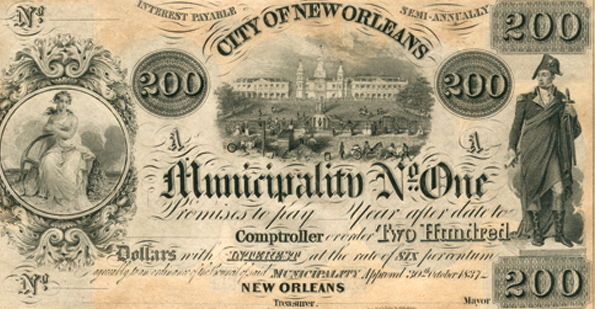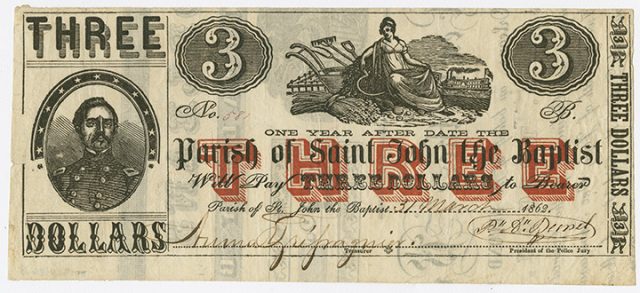Fall 2016
Banknote Bonanza
An exhibit surveys pre-Civil War currency in America with a special focus on Louisiana
Published: September 6, 2016
Last Updated: August 4, 2022

Courtesy of the Historic New Orleans Collection, gift of Boyd Cruise.
City of New Orleans, First Municipality, 200-dollar note (obverse side) printed in New Orleans, Louisiana, October 30, 1837; engraving by John V. Childs.
Louisiana’s first banks — the Bank of Louisiana and a branch of the Bank of the United States — opened on Royal Street in 1805. Each circulated its own notes, extended credit, accepted deposits, exchanged money and engaged in a variety of other financial activities suited to a booming port town. By 1830 New Orleans boasted five banks, and just four years later that number had ballooned to 12. New state-chartered banks — such as the Bank of Orleans, Citizens’ Bank, Mechanics and Traders Bank, Union Bank and Consolidated Association of Planters — competed to underwrite expanding markets in land, cotton, sugar and slaves, all of which could be purchased using paper money.

St. John the Baptist Parish 3-dollar note (obverse side),1862.
The beauty of bank notes was that as long as the public had confidence in their value, banks could print and circulate more paper currency than the amount of specie kept in their vaults. But when trust in that system failed, as it did when transatlantic credit markets contracted in the late 1830s, so too did banks, leaving businesses and individuals holding worthless paper notes. During the Panic of 1837 — one of the worst financial crises in US history — banks suspended specie payments, and creditors ranging from state governments to individual property owners defaulted on their debts. The Panic of 1837 was not the only economic crash of the antebellum period. Markets followed a boom-and-bust pattern throughout the 19th century, with much of the credit available in the South prior to 1865 tied up in cotton and the enslaved laborers who picked it.
The era best represented in Money, Money, Money! is the Civil War, when the United States and its Confederate counterparts, including states, parishes, counties, towns and even merchants, printed vast quantities of currency. Soon after seceding from the Union in early 1861, the Confederate States of America began printing its own paper banknotes. The earliest were printed in New York by the National Bank Note Company and smuggled across Union lines. Subsequent issues were printed in New Orleans; Richmond, Virginia; and Columbia, South Carolina.
State treasuries were also actively engaged in financing the war and state economies. Louisiana mobilized its state banking system in support of the war in 1861, and Governor Thomas Overton Moore issued an order to all Louisiana banks to suspend specie payments in November of that year, leaving the state and its inhabitants to operate in an economy based entirely on paper money. Forty of Louisiana’s 48 parishes also printed their own paper money during the Civil War, and towns across the state sought to satisfy the demand for a circulating currency by turning to the printing press. Even private businesses issued notes redeemable for goods and services when national, state and even municipal notes were too scarce to offer as change.

Copper sou or nine denier piece minted for the French colonies.This coin was minted in La Rochelle, although there were others minted in Rouen. The coins were not successful, since the colonists disliked copper coins, and in 1726 most of the issue was returned to France.
While the Confederacy began printing money at breakneck speed as early as March 1861, the United States struggled to devise its own system for financing the war. Like the Confederacy, the US government turned to paper money. The first federal banknotes, made possible by an act of Congress, appeared in the summer of 1861. These bills, known as Demand Notes, circulated throughout the Union and were officially declared legal tender on February 25, 1862, with the passage of the Legal Tender Act. The green-backed notes appeared in denominations of $1, $2, $5, $10, $20, $50, $100, $500 and $1,000 and were first issued between March of 1862 and March of 1863.
The National Banking Acts of 1863 and 1864 further strengthened federal authority by bringing all banking activities under federal jurisdiction. The acts prohibited nonfederal entities from issuing coins, and, perhaps most important, at least in terms of the creation of a national currency, they made the issuance of banknotes by nonfederal entities subject to taxation, which led the vast majority of banks to cease printing paper alternatives. By 1870 federally issued notes reigned supreme throughout the newly reconciled United States.
Editor’s Note: This article references an exhibit that is no longer on view. For current exhibits at the Historic New Orleans Collection, please visit www.hnoc.org.

